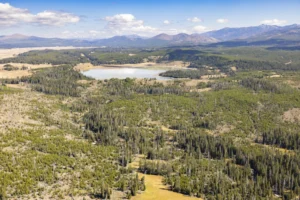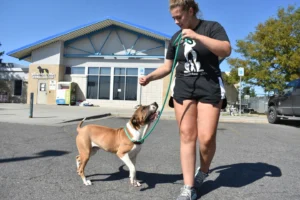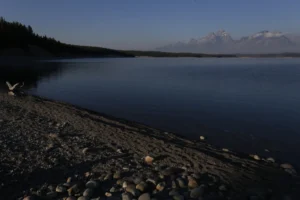Hiker Killed in Suspected Grizzly Encounter Near West Yellowstone
The investigation is ongoing, and an emergency closure is in effect as wardens attempt to locate bears
- Published In: Other News & Features
- Last Updated: Jul 24, 2023

FILE - This April 29, 2019 file photo provided by the United States Geological Survey shows a grizzly bear and a cub along the Gibbon River in Yellowstone National Park, Wyo. (Frank van Manen/The United States Geological Survey via AP)
By Melissa Thomasma
Special to the Wyoming Truth
This story was updated for clarity on July 24, 2023 as of 6 p.m. MT.
Montana Fish, Wildlife & Parks confirmed that a woman was killed in an encounter with a grizzly bear on Saturday near Buttermilk Creek, eight miles west of West Yellowstone, Montana.
The agency was notified by a hiker at approximately 8 a.m. on July 22, that they had discovered a woman’s body on the Buttermilk Trail. In a statement, Montana Fish, Wildlife & Parks said “wardens and bear specialists, along with staff from other agencies, found that the woman had wounds consistent with a bear attack.” Tracks from two grizzly bears were identified near the deceased hiker — one adult and at least one cub.
Evidence indicated that the hiker was traveling alone, the agency said. No bear spray or firearms were located at the scene, and the victim’s identity has not been released as of Monday afternoon.
“The investigation at the scene has wrapped up at this point,” Morgan Jacobsen, information officer for the Montana Fish, Wildlife & Parks, told the Wyoming Truth.
Investigators did not locate any potential feeding or day bed sites in the immediate area, leaving uncertainty around the cause of the incident. Jacobsen said further investigation into the events leading up to the encounter and the collection of forensic details is ongoing in collaboration with other agencies, including the Gallatin County Sheriff’s Office, U.S. Forest Service and U.S. Fish & Wildlife Service.
Jacobsen confirmed that neither ground nor aerial searches have located the animals suspected to be involved. Trapping efforts are underway, Jacobsen said, but no captures have been made yet and the efforts will continue at least through Monday night.
The Custer Gallatin National Forest, in which the incident occurred, has issued an emergency closure for the area “due to the incident’s proximity to residences, campgrounds and a high-use OHV trail system.”
“This is densely occupied grizzly habitat in close proximity to Yellowstone National Park,” Jacobsen said, adding that the “unfortunate incident” was “tragic in so many ways.”
“Most negative encounters are surprises to the bear,” Jacobsen explained. “It’s a situation where a bear is acting defensively — startled at close proximity, protecting cubs or a food source like a carcass.” He underscored that grizzlies do not actively hunt humans.
The experts on the federally-organized Interagency Grizzly Bear Committee agree: bears rarely exhibit predatory behavior towards humans. Both the committee and the Montana Fish, Wildlife & Parks strongly advocate for recreationists to carry and know how to utilize bear spray.
“In a study of bear spray incidents in Alaska, spray effectively deterred undesirable behavior more than 90% of the time,” the committee reported. “In 72 incidents involving 175 people, only three people were harmed, none seriously.”
Jacobsen confirmed that in his experience, “in most situations, when used properly, bear spray will change a bear’s behavior.”
The Wyoming Game & Fish Department encourages all outdoor recreationists to carry bear spray when hiking, camping, hunting or fishing in the state. The agency declined further comment to Wyoming Truth on the incident in Montana, but extended “condolences to the friends and family of the victim and support of the professionals on the ground investigating the tragic situation.”
More bears, more people, more overlap
Over recent years, the numbers of both grizzly bears and humans have increased steadily. Recent analysis of U.S. Census Bureau data revealed that Montana is the second-fastest growing state in the nation; the population expanded by 3.3% between 2020 and 2022. Gallatin County, in which the hiker’s fatality occurred, grew by 4.4% in that time.
According to the Montana Fish, Wildlife & Parks, Montana also boasts the largest population of grizzly bears in the Lower 48 — likely just under 2,000. As of 2021, experts believed that 1,063 grizzlies lived fully or partially within the Greater Yellowstone Ecosystem, which includes territory in Wyoming, Montana and Idaho. Females typically roam a home territory of around 100 square miles, and males can occupy up to 1,000 square miles of home range.
The bear’s successful recovery — up from an estimated 135 bears when the species was first listed as threatened under the Endangered Species Act in 1975 — has caused both state and federal legislators to request that grizzlies be removed from the list. Rep. Harriet Hageman (R-Wyo.) and other delisting proponents are seeking an overhaul to the Endangered Species Act, claiming that it curtails the rights of individuals and businesses.
Wildlife advocates argue that delisting the grizzly is premature and that subjecting the populations to trophy hunting and further pressure would jeopardize the recovery of the iconic North American omnivore.
The Center for Biological Diversity, an environmental protection nonprofit, described the proposed changes to the Endangered Species Act as a “horror show inside a dumpster fire” and is collaborating with non-governmental organizations, Indigenous tribal nations and other stakeholders to stymie the ongoing legislative efforts.













